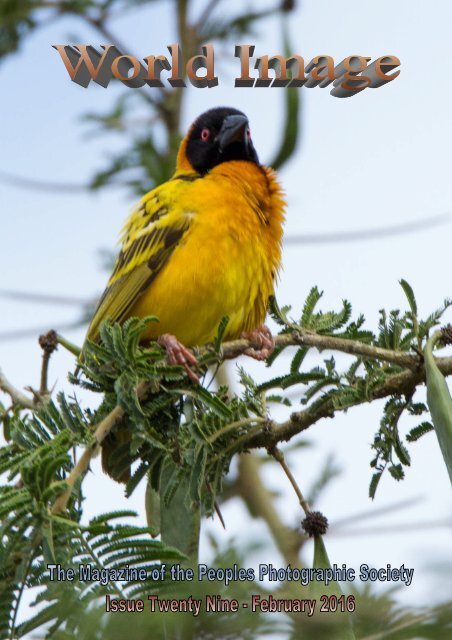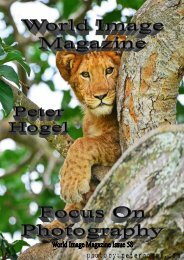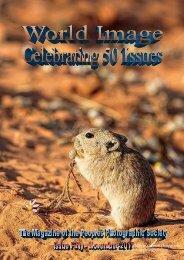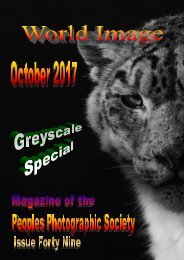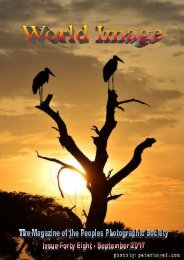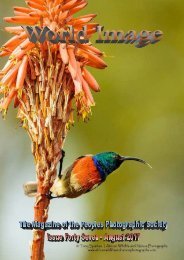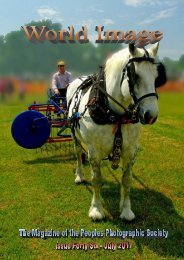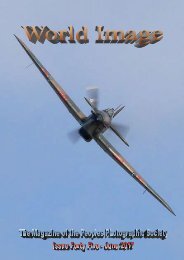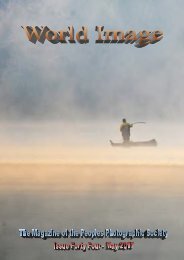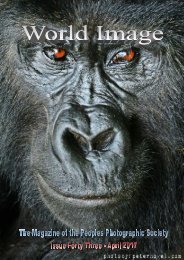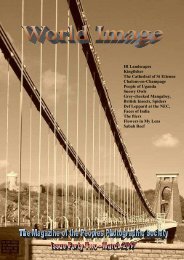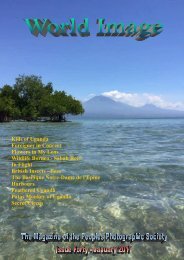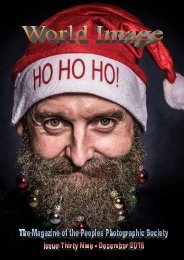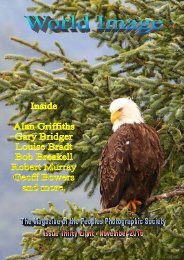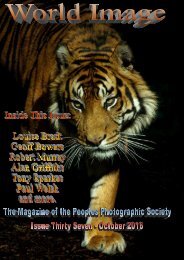World Image issue 29 February 2016
Magazine of Photography and travel and wildlife
Magazine of Photography and travel and wildlife
You also want an ePaper? Increase the reach of your titles
YUMPU automatically turns print PDFs into web optimized ePapers that Google loves.
Website = photosociety.net Page 1 email = magazine@photosociety.net
National and Regional Management<br />
Gordon Longmead - England - CEO<br />
Peter Hogel - Uganda - Deputy CEO<br />
Scott Hurd - Namibia<br />
Tom Coetzee - South Africa<br />
Paul Welch—Australia<br />
Steve Cook - USA<br />
Robert Murray - Scotland<br />
Rabi Chandra Pokharel - Nepal<br />
Tina Andreasson - Sweden and Mexico<br />
Jack Glisson - Kentucky USA<br />
Rodger Lee - Steam Punk Events<br />
In This Issue:<br />
3 <strong>World</strong> <strong>Image</strong> Magazine and the Peoples Photographic Society<br />
Uganda<br />
4 Breakfast on the Nile by Gordon Longmead<br />
5 My Friend…Your Seemingly Terrifying Neighbour by Petit Hogel<br />
8 Cruising on the Nile by Gordon Longmead<br />
13 Clothing Designs by Flavia Mukisa, Kampala<br />
15 A Study in Nature - Kingfisher - Pictures by Scott Latham<br />
16 A Study in Nature - Wildlife of America by Larry Hitchins<br />
17 Wild Horses of Namibia - Pictures by Scott Hurd<br />
18 The Water Cycle - Rain to River to Seas to Rain<br />
20 Winter Chills<br />
22 Kerala Fishermen - Story in Pictures by Robert Murray<br />
24 Tamron 150 - 600 User Review by Gordon Longmead<br />
25 A Study in Greyscale - Sporty Types - Pictures by Alan Griffiths<br />
26 Wildlife of the <strong>World</strong> - Birds of a Feather<br />
28 The Netherlands, Limburg by Paul Weijenberg<br />
31 Unusual <strong>Image</strong> by Kevin W. Moore<br />
32 Portrait Pro, Issue 15 - Review by Gordon Longmead<br />
35 A Study in Nature - Jay, Nuthatch, Yellow Wagtail and Dunnock - Pictures by Scott Latham<br />
36 Wildlife Borneo - Another Day in Paradise 1 - Sabah Reef by Gary Bridger<br />
38 The Beauty of Landscape<br />
40 Exploring Patagonia - Dawn over the top of Fitzroy by Michal Shmelev, Russia<br />
41 Renaissance Faire in Sterling, New York By Monroe Payne<br />
42 A Day With the Wolves Pictures by Rodger Lee<br />
43 South Africa, Hluhluwe – Imfolozi Game Reserve by Ian Bales-Smith<br />
49 Photo Study of Tanzania by Paul Nanyaro<br />
50 Away From the City, America by Larry Hitchins<br />
51 The Societies Show, London<br />
The redesigned January <strong>issue</strong> of the magazine achieved 1720 readers<br />
Please share the link to friends and family so they may enjoy the magazine as well.<br />
www.worldimagemag.com<br />
© Please remember that all articles and images published in this magazine are copyright protected<br />
Cover Weaver Bird by Gordon Longmead<br />
Website = photosociety.net Page 2 email = magazine@photosociety.net
Peoples Photographic Society [PPS]<br />
Founded in September 2013, the society is open to<br />
anyone who enjoys photography regardless of their<br />
level of achievement, or location.<br />
It is open to professionals and beginners and<br />
everyone in between, the only request is that<br />
professionals are willing to teach and all are willing<br />
to learn, and that face book members remain in<br />
contact with the group discussions.<br />
There is only one restriction as regards to types of<br />
photography, so we cater for landscape, portrait,<br />
table top, wildlife, and the natural world, street<br />
scene, and many other areas of interest.<br />
T o J o i n t h e s o c i e t y e m a i l<br />
manager@photosociety.net with Email address,<br />
location (country, state, county, and town for<br />
your formal membership to be registered.<br />
<strong>World</strong> <strong>Image</strong> Magazine<br />
and the<br />
Peoples Photographic Society<br />
www.worldimagemag.com<br />
<strong>World</strong> <strong>Image</strong> Magazine [WIM]<br />
The free magazine was first <strong>issue</strong>d in October 2013<br />
as the journal of the PPS, after the first six <strong>issue</strong>s the<br />
magazine was expanded to include reviews and<br />
articles.<br />
In the second week of October the method of<br />
presenting the magazines was changed to make<br />
access and reading easier. Although we still have<br />
some teething troubles with the off-site storage<br />
location, we will persevere. (If the magazine page<br />
offers a “Broken Page” statement double click the<br />
page).<br />
In November of 2015 the magazine was redesigned<br />
and further developments resulted in over 1720<br />
readers for the January <strong>issue</strong>. Since restructuring the<br />
method in October, the magazines have received<br />
16071 readers. In total, since the magazine was first<br />
published we have had over 70,000 readers with<br />
715,150 page views. [figures correct as of the 13th<br />
January <strong>2016</strong>].<br />
<strong>World</strong> <strong>Image</strong> Magazine on Fine Art America<br />
Peoples Photographic Society Member galleries<br />
http://gordon-longmead.artistwebsites.com/index.html?tab=galleries<br />
As part of the expansion and ongoing development of the <strong>World</strong> <strong>Image</strong><br />
Magazine, we have established a website presence within Fine Art America<br />
for the presentation and promotion, and sale of member images.<br />
Members wishing to add their own gallery should contact<br />
Gordon@worldimagemag.co.uk for details.<br />
Website = photosociety.net Page 3 email = magazine@photosociety.net
Uganda<br />
Breakfast on the Nile<br />
By Gordon Longmead<br />
Imagine the sun rising over the calm reflections on<br />
the river, the fishing boats are already out, and even<br />
their movement fails to disturb the tranquil waters.<br />
In the reeds other birds are watching as we begin<br />
the breakfast feast, they are watching for unwary<br />
insects that may fly past.<br />
The approaching sunrise perculates through the<br />
morning river mist giving the world a purple hue.<br />
The damselflies still hang like a ball in the air, the<br />
dark shadow of a bird dives to the water and skims<br />
across the surface snatching away the insects.<br />
So the sun rises above the hidden horizon behind<br />
this place and another day of safari begins. After a<br />
short visit to Murchison we leave and travel south to<br />
the Ziwa Rhino Sanctury.<br />
Website = photosociety.net Page 4 email = magazine@photosociety.net
My Friend…Your Seemingly Terrifying Neighbour.<br />
Petit Hogel<br />
I want to tell you a story about my friend who cant<br />
speak… I have observed him in great detail and I<br />
would like to speak on his behalf… you see my<br />
friend is like many of your other friends he has traits<br />
and skills that you may notice in the company you<br />
keep.<br />
But you still care about your friend…you call him to<br />
ask him about his day…if any <strong>issue</strong>s that he had<br />
were resolved… but I cannot call my friend because<br />
he does not have a mobile phone… he does not have<br />
an email account. My friend speaks to me but we<br />
cannot speak to each other.<br />
My friend is very fast on his feet…it may not look<br />
fast on the television but trust me he is fast he puts<br />
many sports champions to shame…have you asked<br />
your self why my friend has to run so fast yet he is<br />
massive in weight and hugely intimidating because<br />
he is scared he has seen everyone he knows die at<br />
the hands of the poachers.<br />
I saw my friend the other day at the rhino sanctuary<br />
…he was happy…he was bold…he looked like he<br />
was ready to take on the world… then I asked why<br />
not release him into his natural habitat…then I was<br />
told about the filth called poachers…<br />
I looked at my friend and I felt sad because I go to<br />
bed without a care in the world everyday... I take my<br />
coffee and I am good to go but standing there<br />
looking at my friend playing with his family it<br />
downed on me it could be his last smile…his last<br />
laugh…his last breath ---<br />
poachers…<br />
Website = photosociety.net Page 5 email = magazine@photosociety.net
My friend has a soft spot….no not the kind you<br />
think ….but at the end of the day he is happy…he<br />
rubs the back of his body against things to feel<br />
pleasure….and when you get up to go to work my<br />
friend has been up for a few hours and he goes to<br />
bed when you begin yours…<br />
I made a joke the other day…I told my wife why do<br />
you do these ridiculous vegetarian diet have you<br />
seen the Rhino --- she did not laugh but I bet you<br />
are…<br />
My friend has other friends too ….its just not<br />
me…birds help my friend to let him know that<br />
danger is on its way, I may not be able to call my<br />
friend I may not be able to see him sad everyday,<br />
but at least I know that when he feels alone because<br />
his family has been obliterated by poachers, his<br />
small friends are trying to help him the best way<br />
they know how.<br />
Help my friend like you would help your friends<br />
Words by Petit Hogel<br />
Pictures by Gordon Longmead<br />
Website = photosociety.net Page 6 email = magazine@photosociety.net
Colubus Monkeys by Ben Oleni Ntale<br />
Although there are a number of species of Colobus monkey, five in all with a number of sub-species, the ones we generally<br />
recognise are the black and white Colobus. These old world monkeys are native to Africa and can be found in Uganda. The<br />
thumb of the Colobus is a stump and so appears to be mutilated and thus gained its name in Latin form. They are herbivorous,<br />
eating leaves, fruit, flowers, and twigs. Habitats include primary and secondary forests, the riverine forest of Uganda being an<br />
ideal home, they also frequent lightly wooded grasslands. They live in territorial groups based upon a single male with a number<br />
of females and their offspring. Newborns are totally white.<br />
Kuyimba means 'to sing' in the<br />
Zambian Chinyanja language and<br />
this site is a celebration of the sights<br />
and sounds of southern Africa. Join<br />
us to experience it for yourself.<br />
Derek & Sarah Solomon<br />
www.kuyimba.com<br />
Website = photosociety.net Page 7 email = magazine@photosociety.net
Cruising on the Nile<br />
By Gordon Longmead<br />
The river is wide and long so the surface can get a<br />
bit choppy when the wind blows, but during our<br />
visit the air was still and the sun shone.<br />
The surface of the river had apparently been ironed<br />
flat in places and the reflections were beautiful to<br />
see, the rest was covered in small ripples caused by<br />
the current beneath.<br />
Victoria Nile at the Ferry Jetty.<br />
Crusing on the Nile is a must for any explorer where<br />
ever they may be along the 3000km length of this<br />
river. Open water holds a fascination all of its own.<br />
The question asked in regards to rivers is usually,<br />
”What is out there… hiding from view”.<br />
The first part of the journey was to cross the river to<br />
pick up additional passengers. This was convienent<br />
as it allowed Peter to take the car to the other bank<br />
on the ferry and join the cruse from that side.<br />
We had already seen hippos walking along this far<br />
bank, the Red headed Rock Agama (A.agama)<br />
greeted us at the boat station and the kingfishers<br />
were hovering over the water nearby.<br />
With rivers in much of the world we happily walk<br />
along the river bank and even in the water to find<br />
the answers to that question. Try that in Uganda and<br />
you will quite simply die.<br />
This simple fact not only applies to the rivers but<br />
often to the small ponds that may be on the roadside,<br />
in all standing water danger hides amongst the<br />
beauty of the scene.<br />
There is one way to remain relatively safe, and that<br />
is to remain in the car while on the river bank, or in<br />
a boat on the river. As my host would say, if you fell<br />
from the boat and could swim, the crocs or hippos<br />
would get you, and in the unlikely event you made it<br />
to the shore, the buffalo would get you. So it is a<br />
good idea not fall overboard.<br />
Blue Skies<br />
Red headed Rock Agama (A.agama)<br />
Website = photosociety.net Page 8 email = magazine@photosociety.net
Hippo Mother and Calf on the Far Bank<br />
Once on the water the pace of life changes … ok so<br />
it is at the same slow easy pace, we just start taking<br />
more pictures and enjoying a cold beer when we get<br />
a chance to avert the lens.<br />
A Hippo Pod<br />
The hippopotamus can grow to more then 3m in<br />
length and weigh up to 4000kgs, but despite its<br />
immense size on land it can run at an astonishing<br />
35km/h, (this is much faster than a human, so if you<br />
happen to get to close the hippo will catch you).<br />
Being a vegiterian a person attacked will not be<br />
eaten, that is the good news, the bad news is that<br />
being run down by a hippo is akin to being hit by a<br />
truck with teeth, if the impact fails to kill you the<br />
teeth undoubtedly will. In defending its pod, the<br />
dominant hippo will fight to the death.<br />
Elephant Family leaving the river<br />
While we are looking for the wildlife associated<br />
with the river, it is easy to assume that we will not<br />
see land animals, so the first encounter is with a<br />
heard of elephants on the embankment who have<br />
been to the shore to drink.<br />
Within a short distance you may see some brown<br />
humps in the water. These would be a pod of hippos.<br />
They spend most of the daytime in the water,<br />
coming out only to feed, most of which is done<br />
during the night. They will eat between 45 and<br />
60kgs of grass each day.<br />
Although spending most of the time in water, the<br />
hippo is a poor swimmer, the water helps to protect<br />
them against sunburn to which they are vunerable.<br />
They have few predators, although the young may<br />
be vunerable if seperated from the pod, but this is<br />
unlikely to happen.<br />
Watchful Hippo<br />
Now I mentioned earlier the dangers of walking<br />
along the river bank of the Nile, one of those is of<br />
course the snakes. I did not see any during this trip,<br />
but then I was on the boat and not on the bank.<br />
There are pythons and a number of other poisionus<br />
snakes lurking about so be aware. Getting bitten by<br />
a poisionus snake in the wilds of Uganda makes you<br />
realise just how far away help really is. Thankfully<br />
the general tourist is unlikely to be faced with that<br />
situation but it is as well to be aware of the danger.<br />
Website = photosociety.net Page 9 email = magazine@photosociety.net
Either way these are very dangerous and should not<br />
be approached even if they are smiling. For an<br />
animal with such a relaxed appearance, these can<br />
move surprisingly fast.<br />
The Nile Crocodile (Crocodylus niloticus)<br />
One of the dangers that may be lurking there is the<br />
smiling assin.<br />
Waterbuck (Kobus ellipsiprymnus defassa)<br />
Further along the bank and watching intently was a<br />
small group of Waterbuck. These can be found in all<br />
of the national parks and often outside the parks in<br />
open countryside. With age they also discover safer<br />
places to rest.<br />
Not all crocs rest in the water<br />
The Nile Crocodile attacks its prey on the shoreline<br />
and drags it into the water. This individual is seen<br />
resting under bushes close to the water, but is very<br />
well aware of the potential lunch on board the boat.<br />
These are often seen floating in the water, but spend<br />
much of their aquatic time stalking below the water<br />
line or, as in this case, on the embankment either<br />
hiding, sunbathing or just greeting visitors.<br />
Dentists welcome, no appointment needed<br />
Waterbuck (Kobus ellipsiprymnus defassa) male<br />
There are many animals you would expect to<br />
discover inside the Murchison Falls National Park,<br />
and indeed you will need a good supply of batteries<br />
and cards for your stay. I used two 32gb SD cards in<br />
two days and could easily have taken more.<br />
The end point where we turned round and headed<br />
back to the boat station, was at the famous<br />
Murchison Falls, I am not going into detail in this<br />
article as it will be covered in ’Power of the Nile’. It<br />
is well to note that upstream of the falls the water<br />
has a great deal of power, and downstream it has lost<br />
much of that power as the river widens forming a<br />
good environment for wildlife.<br />
Website = photosociety.net Page 10 email = magazine@photosociety.net
The return journey also had its sightings, including<br />
the wild pigs known as Warthogs. Hard skin, wire<br />
for hair, these are powerful if skittish animals.<br />
In the earlier part of this article I made comment that<br />
if the crocs and hippos did not get you the buffalo<br />
would.<br />
The picture shows just a small group of the buffalo<br />
in the park, the main herd numbers well over 400 we<br />
know this because we actually drove through the<br />
herd a few days later.<br />
Warthogs (Phacochoerus africanus)<br />
Returning to the ’deer’, we then found the Jackson<br />
Hartebeest. This is an animal with a very short<br />
memory, so much so that if being chased by a<br />
preditor it will stop running having forgotten why it<br />
was doing so.<br />
Giraffe (Giraffa camelopardalis)<br />
The Giraffe needs little introduction, however there<br />
are different varieties. I am informed that as the<br />
animal ages the pattern darkens so this animal would<br />
not be a youngster, but the subspecies are also<br />
distinguished by colour which can make<br />
identification difficult.<br />
Jackson Hartebeest (Alcelaphus buselaphus jacksoni).<br />
And so we come to one of the aggressive and most<br />
dangerous animals found in the Murchison National<br />
park second only to the hippo.<br />
Baboon troop are just specks on the shoreline<br />
You need to look closely at the shore line and in the<br />
shadow by the bush on the left to see the baboon<br />
troup (Papio cynocephalus) while a heron sits in that<br />
same bush watching proceedings.<br />
These troups are seen throughout the park, the<br />
largest troup, numbering up to 100 individuals, is<br />
seen just inside the southern entrance.<br />
African Buffalo (Syncerus caffer)<br />
There is a policy of not feeding any of the animals,<br />
but this is especially important with these apes. They<br />
will try to enter your vehicle, especially if you have<br />
bananas, and they are very dangerous.<br />
Website = photosociety.net Page 11 email = magazine@photosociety.net
Baboon Troup (Papio cynocephalus)<br />
When writing about crusing on the river in such a<br />
location, it is easy to get so focussed on the wild life<br />
that we forget that there is more to the scene than<br />
animals.<br />
There is also an abundance of aquatic plantlife and<br />
birds. I mention them here because I did not want<br />
you to think I had forgotten them.<br />
Fact is that I will be looking at them in another<br />
article.<br />
It may have been noticed that I left the best until<br />
last, the iconic image of the African Elephant<br />
(Loxodonta africana).<br />
African Elephant (Loxodonta africana)<br />
But pride of place must go to the grandmother of the<br />
Nile Crocodiles on the Victoria Nile in Murchison<br />
National Park.<br />
I hope you enjoyed this brief glimpse of the larger<br />
wildlife, Next month I will be looking at the many<br />
birds that could be seen.<br />
Visiting Murchison is not a right, it is a privillage,<br />
seeing the wildlife in natural habitat is not a<br />
privillage, it is a right.<br />
Gordon Longmead<br />
Website = photosociety.net Page 12 email = magazine@photosociety.net
Photoshoot Kampala<br />
Clothing Designs by Flavia Mukisa, Pictures by Gordon Longmead<br />
While in Kampala in 2015, I had the opportunity to do a photoshoot with Flavia Mukisa and some of her<br />
friends who modelled some of Flavias creations.<br />
Flavia Mukisa is a freelance<br />
FlavAfrique Creations.<br />
model and model and fashion designer, she is the Managing Director of<br />
Flavia Mukisa<br />
Steven Hodges<br />
Annet Jackson<br />
Latosha Malaika<br />
Hudson<br />
Mary Tumusiime<br />
Website = photosociety.net Page 13 email = magazine@photosociety.net
Color Confidence launches ‘Inspired by Colour’<br />
photography competition<br />
Birmingham, UK, 13 January <strong>2016</strong>. Earlier this month, Color Confidence launched an exciting new<br />
photography competition that will encourage people to experiment with colour in their every day<br />
lives.<br />
The ‘Inspired by Colour’ competition is featured around a different photography theme each month<br />
and gives both amateur and professional photographers the chance to win great prizes from some of<br />
the industry’s leading manufacturers.<br />
“Our exciting new photo competition is a great opportunity to give budding photographers great<br />
exposure and to encourage them to get creative with colour,” says Geoffrey Clements, Managing<br />
Director at Color Confidence.<br />
Geoffrey Clements continues: “Colour management is at the forefront of all that we do here at Color<br />
Confidence. Using great value colour management solutions and equipment as prizes, will hopefully<br />
encourage more photographers to incorporate colour management into their workflow.”<br />
The competition can be entered via the Color Confidence Facebook page. Throughout the month, the<br />
public will vote for their favourite image. The person with the most votes at the end of each month<br />
will win a great prize (minimum prize value £100).<br />
Each winning image will be displayed on the Color Confidence website, in the monthly newsletter, on<br />
the social media sites, and featured in the Color Confidence Blog.<br />
At the end of the year, the Color Confidence team will judge the 12 winning images to determine who<br />
will be crowned ‘Color Confidence Photographer of the Year <strong>2016</strong>’.<br />
The grand prize winner will receive a fantastic prize bundle made up of £1,000 worth of photography<br />
equipment from leading manufacturers such as X-Rite, NEC, ExpoImaging, BenQ and DxO software.<br />
January’s theme is ‘Street Photography’. This month’s prize is an X-Rite i1Display Pro (worth £207<br />
incl. VAT) - the ultimate solution for photographers that demand speed, options and flexibility to<br />
attain colour accuracy.<br />
For more information and to enter the competition, visit the ‘Photo Competition’ tab on the Color<br />
Confidence Facebook page: www.facebook.com/ColorConfidence. Mobile users can access the<br />
competition here: https://a.pgtb.me/LjqVx0.<br />
Website = photosociety.net Page 14 email = magazine@photosociety.net
A Study in Nature - Kingfisher<br />
Pictures by Scott Latham<br />
My little 600d doesn't like higher iso this is only set<br />
at 800. Way more than I'd ever use normally. I also<br />
has just 3fps which is actually more around 1 frame<br />
per 3 seconds, trying these rising and diving shots<br />
was a nightmare and required single shot<br />
judgement. I'll crack it eventually.<br />
Website = photosociety.net Page 15 email = magazine@photosociety.net
A Study in Nature<br />
Wildlife of America by Larry Hitchins<br />
Cooper's Hawk<br />
Yellow Breasted Chat<br />
Red Shouldered Hawk<br />
Juvenile Bald Eagle 2nd year notice the beginnings of<br />
the White "Bald Head" and shortening of the flight<br />
feathers<br />
Yellow Billed Cuckoo They like the upper part of the trees<br />
and not often come down low I've only seen them twice in 7<br />
years low enough to photograph.<br />
Prothornatory Warbler<br />
Website = photosociety.net Page 16 email = magazine@photosociety.net
Wild Horses of Namibia<br />
Pictures by Scott Hurd<br />
Scott and Judy Hurd spend as much time as possible helping and photographing these endangered nomads<br />
of the Namib desert. Water and minerals are not easy to find and so they are raising funds to provide<br />
supplements to help the horses survive the long treks between water sources. For example, a saltlick can<br />
sustain a herd of these horses for a few days and only costs a few pounds. For those wishing to help in this<br />
task, please contact scott@h4urd.co.uk by email or you can do so through this magazine.<br />
Website = photosociety.net Page 17 email = magazine@photosociety.net
The Water Cycle<br />
Rain to River to Seas to Rain<br />
The Rains Came to Namibia by Scott Hurd<br />
We all know about water, we can’t live without it,<br />
although sometimes in the world of nature we often<br />
wish we could.<br />
So we can explore the cycle in its many forms from<br />
the perfect reflections in the coastal water of Britain,<br />
to the misty shoreline of the USA.<br />
With our changing weather patterns floods are<br />
happening more frequently and droughts are longer.<br />
Where once the snows fell and allowed the water to<br />
seep slowly into the ground as it thawed, now it falls<br />
as rain and the ground can not cope.<br />
But where photography is concerned, all these<br />
events are fodder for the lens. From the record<br />
images of the floods to the tranquil vista of the<br />
lakes, and the moody changes of the oceans.<br />
Surfing on a foggy day. Water & fog but no sunshine.....<br />
by Georgene Bergstrom<br />
Water always attracts the photographer even though<br />
it can destroy the equipment they use. How often<br />
have we heard about the camera disappearing into<br />
the river?<br />
Erosion by Matthew Brooks<br />
So keeping the strap firmly secured to the wrist we<br />
can venture into the danger area. Take due care as<br />
water can be as unpredictable as the banks and<br />
beach on which you stand. Be aware also of the<br />
rogue wave that comes in to shore un-announced.<br />
Website = photosociety.net Page 18 email = magazine@photosociety.net
"Sunlight on the Water". Late sunlight illuminates a<br />
breaking wave, while it lights up the snow-covered hills<br />
several miles away on the other side of the Moray Firth<br />
in the north of Scotland. By Robert Murray<br />
And bigger.<br />
Woodland puddle! By Alan Culley<br />
So from the still water of the transient pond in the<br />
wooded glade, we see the gently lapping waters of<br />
the shoreline on a calm day.<br />
The breakers on a beautiful day at Lossiemouth on the<br />
Moray coast of Scotland, by Robert Murray<br />
But there is one time the water is loved by all, a<br />
calm evening siting on the western coasts with a<br />
glass of wine (or water) as the sun slowly sets. So<br />
until the next <strong>issue</strong>.<br />
A crisp autumn shoreline at Wells College in Aurora,<br />
New York by Monroe Payne<br />
While the sun shines somewhere far away the wind<br />
is blowing and the currents of the oceans are moving<br />
creating the waves. Some small and friendly, others<br />
large and powerfully dangerous.<br />
But all great things start from small beginnings, the<br />
waves are no different. They grow with time small<br />
breakers get bigger.<br />
Australian Sunset in Darwin by Geoff Bowers<br />
Website = photosociety.net Page 19 email = magazine@photosociety.net
Winter Chills<br />
Winter chills in the photographic sense has little to<br />
do with cold remedies and handkerchiefs. Instead it<br />
has to do with snow and ice.<br />
Ice Flower by Brian Chalmers<br />
Woodland Path by Gordon Longmead<br />
Some of us still remember waking up on Christmas<br />
morning to a fairytale world dressed in white snow.<br />
In sixty years this has changed to a damp drizzly<br />
overcast day, but we still get the snows and the<br />
heavy frosts.<br />
Many of the autumn seed heads are still standing<br />
and fill with snow or just be shrouded in white.<br />
A Beautiful Place by Brian Chalmers<br />
Rivers and lakes are a favourite all year round, but<br />
in the cold of winter they take on a new life. Some<br />
freeze over giving both reflections and patterns over<br />
the surface.<br />
Rosie having fun by Brian Chalmers<br />
There are always those who love the cold fresh<br />
snow, in this picture Brians dog Rosie is apparently<br />
making the canine version of snow-angles.<br />
The snow and frost changes the appearance of<br />
everything that we took during the summer, and<br />
regardless of the picture we take the scene has<br />
changed.<br />
One of the hardest things to photograph is the<br />
snowflake, they melt to fast, but there is a way by<br />
cooling a baking tray. Then the trick is to catch a<br />
single snowflake.<br />
Good luck to those who try it, icicles are easier as<br />
they stay in place longer, but remember to allow<br />
time for your camera and lens to cool down when<br />
you walk outside.<br />
I would also suggest you leave the camera in the bag<br />
when returning home and allow it to warm up. Any<br />
Website = photosociety.net Page 20 email = magazine@photosociety.net
Frozen Puddles by Georgene Bergstrom<br />
moisture in the air will find its way to the cold of the<br />
camera and condensation is not a friend of our<br />
equipment.<br />
I will leave you with this selection of natural icescapes<br />
by Georgene, and we will see what come in for the next<br />
<strong>issue</strong>.<br />
Gordon<br />
Figures in ice by Georgene Bergstrom<br />
Figures in ice by Georgene Bergstrom<br />
Website = photosociety.net Page 21 email = magazine@photosociety.net
Kerala Fishermen<br />
Story in Pictures by Robert Murray<br />
1. The heavy boats loaded with nets take a lot of muscle<br />
power to get into the water.<br />
2. The crew at the ready.<br />
3. Timing the launch between the breakers.<br />
5. The long pull.<br />
4. The boat lays a semi-circle of net while the shore team waits.<br />
Website = photosociety.net Page 22 email = magazine@photosociety.net
6. The net comes in. 7. The catch.<br />
8. It is a very labour intensive method of fishing. I don't know how they share the rewards.<br />
Website = photosociety.net Page 23 email = magazine@photosociety.net
Tamron 150 - 600<br />
Gordon Longmead<br />
Having now used the Tamron 150 - 600 in very dull lighting as well as bright sunshine, I thought you may<br />
like to see the results in contrast to each other. The Moorhen and the Dunnock were both taken in my<br />
garden which is shrouded by trees at the best of time.<br />
This day it was very dull and grey with light drizzle. The Weaver Bird was taken on an overcast day at<br />
Mboro NP, while the African Fish Eagle was in full sun. All were taken from about the same distance.<br />
Generally the lens is fast, silent and responsive. It is well built even if I did get a non UK made version, it<br />
cost £600 instead of the recommended £945, so the difference paid my airfair to Uganda to test the lens. Am<br />
I pleased with the lens? Yes is the short answer. I only wish it was lighter.<br />
Website = photosociety.net Page 24 email = magazine@photosociety.net
A Study in Greyscale - Sporty Types<br />
Pictures by Alan Griffiths<br />
Silver Surfer, Thinking About It<br />
Photography is not all about colour, it is more about the way in<br />
which the colours interact with each other to produce the pictures<br />
that we see.<br />
Still Thinking About It<br />
We can sometimes select the colours , or<br />
as in these images, we can chose to<br />
remove the colour spectrum and view in<br />
the shades of grey.<br />
The Cycle Race<br />
Croquet<br />
How we wished we had spent our Sunday<br />
Website = photosociety.net Page 25 email = magazine@photosociety.net
Wildlife of the <strong>World</strong><br />
Birds of a Feather<br />
One of the subjects that occurs in almost every place<br />
we visit is the birds. There are laws in place that<br />
every photographer must abide by, the main one<br />
being not to photograph birds on the nest.<br />
In many countries this requires a special licence.<br />
The reason is to protect the nest from disturbance.<br />
Some nests you can see clearly from a distance<br />
where the intrusion is not a problem for the birds, so<br />
there is not a problem.<br />
Flamingos by Nam Prasad Satsangi<br />
Moorhen by Gordon Longmead<br />
The Moorhen, usually found near rivers, is the latest<br />
visitor to my back yard, and I am a long way from<br />
the river.<br />
Dunnock by Gordon Longmead<br />
The fact is that to take pictures of birds you do not<br />
even need to leave your own garden, in the last two<br />
years 43 varieties of bird have visited my own<br />
garden.<br />
If you live in a place with no garden, how about a<br />
friends garden or local park. Birds are everywhere<br />
so there is no excuse for not practicing or taking that<br />
perfect picture.<br />
Bald Eagle in Alaska by Bob Breakell<br />
Website = photosociety.net Page 26 email = magazine@photosociety.net
Ok, so the birds that visit your home or local parks<br />
will not be the same in the UK as they would be in<br />
Africa or the USA, but then if you reside in the USA<br />
or Australia you will not see the same birds as you<br />
get in the UK.<br />
Spotted owlet Bharatpur by Nam Prasad Satsangi<br />
Similar species are found in all continents, some are<br />
easier to spot and photograph than others, especially<br />
in the wild. But just because a species is not native<br />
to your country does not mean you can not get their<br />
pictures.<br />
There are many places where non-native birds can<br />
be photographed, private owners, bird parks, zoos,<br />
are the obvious locations, and there are always<br />
holidays abroad.<br />
Supper Time, Pied Kingfisher<br />
By Peter hogel<br />
Most places have their Kingfishers, in the UK we<br />
have small, very fast, blue Kingfishers that frequent<br />
our rivers and lakes. The Pied Kingfisher is much<br />
larger but still eats fish. What I found surprising was<br />
the number of varieties of them and that there are<br />
Kingfishers that do not eat fish.<br />
Grey Crowned Crane by Martin Clarke<br />
You would be hard pressed to decide if a well taken<br />
picture of an exotic bird was taken in the wild or in<br />
the local zoo. There is a very important point to note<br />
here, no one minds where you take the picture, but<br />
never state that an image of a captive bird was taken<br />
in the wild. It is that dishonesty that is objected to.<br />
Shoebill Stork - Mabamba Bay - Lake Victoria, Uganda<br />
by Ben Oleni Ntale<br />
I leave you with the only remaining ‘prehistoric’<br />
bird that we have, the Shoebill Stork.<br />
We will continue this glimpse into the bird world in<br />
future <strong>issue</strong>s.<br />
Gordon<br />
Website = photosociety.net Page 27 email = magazine@photosociety.net
The Netherlands<br />
Limburg, historical left overs from the coal mine era.<br />
By Paul Weijenberg<br />
Just for the record: most images are made on<br />
negative film. Let's take a walk and see what's there!<br />
The coal mines were of utmost importance to<br />
Southern Limburg. The mines were visible from<br />
passing trains. There is one railway that is<br />
constructed just for the workers of the coal mines.<br />
This railway had to cut trough hills, cross rivers, and<br />
the cost was 1 million (Dutch guilders, 450.000<br />
Euro) for each kilomter! That line is called in Dutch<br />
"Miljoenenlijntje", little line of millions….<br />
This train starts in Valkenburg, a well know town<br />
for tourists that visit Limburg.<br />
The female on the left is my mother, we write the<br />
year 1988.<br />
This is another view of that railway and how it fits<br />
in the landscape. This train is no longer in use.<br />
When the mines closed in the seventies, much<br />
disappeared in the process that was called: "from<br />
black to green".<br />
This is a view as it was in 1984, the mine site in the<br />
background is history:<br />
Here is the train as it travels today, the most<br />
beautiful train ride of the Netherlands.<br />
Former mine terrain was converted to serve the<br />
public.<br />
A ski-course, a horse track, and a site for events,<br />
such as the pop-concert Pinkpop and a golf course.<br />
Website = photosociety.net Page 28 email = magazine@photosociety.net
This are stables and a training school for horse<br />
riding.<br />
Just over the Belgian border, the same happened.<br />
Few was saved from demolishing. This is Genk, the<br />
(in)famous coals mines of Waterschei. Many found<br />
their graves here.<br />
The scale of the buildings from that period is visible<br />
in the picture. The white line I added points to an<br />
adult, alomst lost in that space.<br />
The golf course is a beautiful site with a lot a hills<br />
and valleys.<br />
Many symbols of the past vanished in a few years<br />
time. In my town, where the largest mine was<br />
(Wilhelmina, after the queen that ruled when the<br />
mine was founded), this symbol was kept, and<br />
placed at the entrance of the leisure park.<br />
My home town Kerkrade was very much depending<br />
on their mines for their income and in fact their<br />
social life and welfare as well. The mines provided<br />
everything.<br />
Website = photosociety.net Page <strong>29</strong> email = magazine@photosociety.net
The workers were highly appreciated. A<br />
monumental sculptur of such a worker stands on the<br />
town square, you see it on top, just left next to the<br />
trees. He carries a mine-lamp in his right hand.<br />
A world wide industry, DSM (Dutch State Mines) is<br />
visible here. It processed the gases and chemical<br />
compounds that came from the mines. After the<br />
mines closed, the DSM converted to making high<br />
tech farmaceutical compounds, plastics and such.<br />
This plant in Geleen is visible in the image in the<br />
distance at the horizon.<br />
Paul<br />
Website = photosociety.net Page 30 email = magazine@photosociety.net
Unusual <strong>Image</strong> by Kevin W. Moore<br />
This is one of the most unusual images I have taken.<br />
I was at a conservation area near Petrolia, Ontario<br />
shooting scenes of fall when I noticed a single red<br />
maple leaf floating atop the pond.<br />
As there was no breeze what-so-ever, and a stump at<br />
the waters edge that I could use to brace one foot, I<br />
decided to try for a shot. I managed to secure my<br />
footing, looked through my view finder until I had<br />
the shot steadied, and "click." All I saw through the<br />
view finder was the leaf. There was nothing else. No<br />
ripples. No reflection. Nothing!<br />
When I got home, I went to my computer,<br />
downloaded my images from the day, and then<br />
looked through them. When I got to this image I<br />
stopped. I was rather taken aback by what I was<br />
looking at as it appeared that, along with the leaf, I<br />
had captured something eerie, something that I am<br />
unable to explain.<br />
There was NOTHING else visible on or in the water<br />
when I took the shot. All other images were of fall<br />
colours with no strange, ghostly images in them. I<br />
can not offer any explanation as to this apparition.<br />
Several people have looked at the full size, original<br />
file and can offer no explanation. It is not a double<br />
exposure. It is not a photo-shopped image. It is<br />
simply strange, ghostly and eerie.<br />
Website = photosociety.net Page 31 email = magazine@photosociety.net
Portrait Pro, Issue 15 - Review<br />
Portrait Pro is a software package designed to make<br />
changes to the faces in your pictures. These changes<br />
can be anything from simple lighting changes to full<br />
glamour sculpting of the face.<br />
It provides a shortcut for the enhancement of<br />
pictures containing faces, but is primarily aimed at<br />
the portrait photographer.<br />
I did review the older software in a previous <strong>issue</strong> of<br />
the magazine and the first thing to note is that the<br />
basic framework is generally unchanged. The<br />
enhancements are confined to additions to the<br />
enhance photo controls to the right of the screen.<br />
First of all we can look at the images from<br />
Anthropics, I could reproduce these but there is not<br />
much point. Like all new and enhanced software, it<br />
take time to develop the skills required in mastering<br />
the techniques involved.<br />
The lipstick colour pallet and texture options have<br />
been enhanced to give more control and variation so<br />
that you can get it right for the look you want.<br />
It is noticeable that with some colours you lose<br />
definition in the lips. Not all colour suits all people,<br />
but from a purely photographic viewpoint, the lip<br />
colour area, especially in the picture above, looks<br />
false over the top lip. I feel that a little blending is<br />
needed in this area of the preset.<br />
This is certainly true when it comes to fashion and<br />
make-up. For the pro make-up artists the subtlety in<br />
changes should be second nature, but for us mere<br />
mortals the prospect of turning a beautiful woman<br />
into a scene from a horror movie is all to real.<br />
But help is at hand with the many and varied presets<br />
contained in the software so that the beginner can<br />
still achieve good results without getting involved in<br />
the refinements of the sliders.<br />
In any image of the person or animal, the first thing<br />
we look into are the eyes, so they need to be right.<br />
The controls for basic changes remain unchanged,<br />
but there is now an option for changing the make-up<br />
using eye shadow, mascara and eye liner.<br />
Personally I like the skin smoothing options in the<br />
presets. While some faces, mostly men, need to<br />
retain the character in the facial lines, I do not<br />
believe that applies to young ladies. Where ladies<br />
are concerned, it is the duty of the photographer to<br />
present them in the best possible manner befitting<br />
their age.<br />
The presets can take years off the age of a person,<br />
but over do it and the project looks as false as it is.<br />
While the appearance of a face can be adjusted, the<br />
underlying age can not. Stay within reason and all<br />
will be well.<br />
We now have a photo-realistic mascara to make the<br />
eyes stand out, presets for the most fashionable<br />
eyeliner styles and a full spectrum of eyeshadow<br />
colors and shapes to choose from.<br />
PortraitPro 15 incorporates new technology to<br />
improve mouth detection which saves time on the<br />
earlier version of the software. Like all facial<br />
adjustments, they should be subtle and in keeping<br />
with the overall image to avoid the horror movie<br />
result.<br />
Website = photosociety.net Page 32 email = magazine@photosociety.net
Another change to this software is the enhanced<br />
bronzing, highlighting and blusher components used<br />
to emphasize and flatter the subject's features.<br />
The Child Mode is designed to bring out children’s<br />
natural beauty, enhancements being optimized to<br />
sensitively improve the portrait.<br />
There are new skin colouring options allow you to<br />
correct for any lighting situation and give skin a<br />
healthy, natural glow.<br />
However it is at this point I do have a problem in<br />
that it treats male and female children in the same<br />
way.<br />
The new Lens Correction slider fixes distortion caused by a<br />
wide-angle lens (commonly known as selfie distortion),<br />
creating more natural-looking, flattering portraits.<br />
Presets are available to shorten the nose and the area<br />
below the nose, change the eye colour and even to<br />
open the eyes a little.<br />
I am a little concerned that whitening the teeth<br />
makes changes to the eyes, but all is not lost since<br />
plumping the lips will change them back again.<br />
Before moving on there is one small problem I<br />
should mention, not so much to do with the<br />
software, but the original image.<br />
Many times when we take portraits in the studio or<br />
outside, we make the mistake of getting bright<br />
highlights or burn-out in the face or hair. No matter<br />
how much you may wish it, this software is not<br />
designed to deal with this error. Try to cover it and<br />
the skin will look awful. If you use RAW files, try<br />
to correct this before using Portrait Pro by reducing<br />
the highlights.<br />
The promotional images show the effects on the<br />
female, but imagine a boy with the cute smooth lines<br />
of a baby doll face.<br />
Overall the software is very good and does what it<br />
sets out to do. The presets can give a beginner the<br />
end result without the learning requirement.<br />
To make the most of the software you need to study<br />
and learn the effects of the individual sliders. Also<br />
how the effects of one slider can change when using<br />
others.<br />
The refinement of the images that are shown<br />
previously in this article have been accomplished by<br />
professionals who use this product, so they may be<br />
finely tuned to present the software in its best light.<br />
I am not a professional user of this software, but I<br />
have been playing with the new version. I have used<br />
the same images as with the previous release with<br />
pleasing results.<br />
Website = photosociety.net Page 33 email = magazine@photosociety.net
The three pictures above show my friend Stacy. The first picture is the cropped original, otherwise<br />
unaltered. The center image was created in an earlier version of the Anthropics software, and the third was<br />
created in the version 15. Is there an improvement between the two versions? I think so.<br />
There are variations on a theme, Starting with the Glamorous preset (left), the center image is with one of<br />
the make-up presets (1) and the second is with another (3). The software also has options for black and<br />
white conversions. While you might think that these are best left to other<br />
dedicated software, this is different, for a start it does present some novel effects.<br />
Overall the software is good, and gets better with practice. Some elements could<br />
do with adjustment, but those are minor. Nine from ten is a reasonable score, and<br />
I wonder where they will take it next. So long as they do not lose sight of the<br />
purpose of the software, and leave some of the work to the skill of the user, all<br />
should be well.<br />
Gordon<br />
Website = photosociety.net Page 34 email = magazine@photosociety.net
A Study in Nature<br />
Jay, Nuthatch, Yellow Wagtail and Dunnock<br />
Pictures by Scott Latham<br />
The Jay<br />
Yellow Wagtail<br />
Nuthatch<br />
Dunnock<br />
Website = photosociety.net Page 35 email = magazine@photosociety.net
Wildlife Borneo - Another Day in Paradise 1<br />
Sabah Reef by Gary Bridger<br />
The underwater world of Sabah Reef is threatened by development and irresponsible tourism. Here is just a<br />
glimpse of the fragile beauty that may soon disappear.<br />
Website = photosociety.net Page 36 email = magazine@photosociety.net
Website = photosociety.net Page 37 email = magazine@photosociety.net
The Beauty of Landscape<br />
We know that the landscapes we see vary by<br />
country. Canada has the vast areas of forest, Austria<br />
and Switzerland has its mountains, Africa has the<br />
Desert etc., we know of these because we were<br />
taught this in school, and of course the teachers were<br />
always to be believed.<br />
These images by Alan Culley are like many of the<br />
places I have been walking round for the last 55<br />
years.<br />
But of course that is only true in a very superficial<br />
way, the whole truth is very different. For a start<br />
Africa is a continent not a country and contains<br />
everything from the desert to mountains and forests.<br />
The same applies to every other country in its own<br />
way, even the polar regions have their plains and<br />
mountains, and far from being covered in snow, they<br />
have the variety in the rocks and ice flows.<br />
For many of us the landscape we know is around our<br />
homes . This creates a problem because we become<br />
blind to the natural beauty of our own world.<br />
Two Knebworth Landscapes by Alan Culley<br />
I had become blind to the views because I had seen<br />
them so often, but others have never seen them, until<br />
now.<br />
Meadows at Gulmarg by Nam Prasad Satsanhttps://<br />
People see landscapes in different ways, even when<br />
it comes to the same view from the same place.<br />
Each photographer applies their own style to the<br />
final picture.<br />
Two Knebworth Landscapes by Alan Culley<br />
I am still guilty of this when I walk out with the<br />
cameras. I look for the wildlife and the unusual and<br />
miss the overview.<br />
One thing I have noticed is that photographers also<br />
have their own preferences as to the type of<br />
landscape they take. Add to that the various methods<br />
of treating the image and the variety and scope of<br />
the imagery expands exponentially. Success is in<br />
the eye of the photographer, we do not all like every<br />
style.<br />
Website = photosociety.net Page 38 email = magazine@photosociety.net
Derbyshire in Infrared<br />
By Alan Griffiths<br />
Bad weather make a interesting sky by Alan Griffiths<br />
Landscapes can be changed just by the weather. In<br />
this picture by Alan Griffiths the scene has become<br />
moody and forboding, The heavy clouds give the<br />
impression of there being a storm on the way.<br />
Two other processes that work well, the first is<br />
infrared. If you think that skill is needed to take in<br />
greyscale, try imagining the world in shades of heat.<br />
The second is the HDRI (High-dynamic-range<br />
imaging ). This needs to be applied, and the subjects<br />
chosen, very carefully for this to work effectively.<br />
Jesus Green lock, Cambridge<br />
By Matthew Brooks<br />
We always see landscape in colour, that is our<br />
world, but how many realise that other animals see<br />
the world differently. Dogs see in Greyscale, so why<br />
not create our pictures in greyscale. Not all<br />
landscapes work well as pictures in that format, but<br />
there is a skill in finding those that work.<br />
The view from my parents in law in Clayton,<br />
California, just outside of San Francisco at the foot of<br />
Mount Diablo by Louise Bradt<br />
Gordon<br />
Website = photosociety.net Page 39 email = magazine@photosociety.net
Exploring Patagonia<br />
Аргентина - Argentina<br />
Dawn over the top of Fitzroy - Рассвет над вершиной Фицрой<br />
By Michal Shmelev, Russia<br />
Погодные споты в окрестностях горы накануне<br />
публиковали неутешительные данные: ветер 38<br />
узлов, облачность 98%. Это означало, что<br />
ближайшие дни будет лить как из ведра, да с этакими<br />
приятными шквальными порывами воды и ветра...<br />
Вполне типично для этих мест. Информацией<br />
поделились испанцы, пришедшие обороткой.<br />
Я решил свернуть лагерь, по сухой тропе спустился в<br />
поселок и разместился в отеле. Однако, по привычке<br />
проснувшись в 4 утра, увидел звёзды за окном. Уже<br />
через полчаса я встречал этот нежно-розовый и<br />
чистый, столь редкий для этих мест рассвет,<br />
длившийся не более двух минут.<br />
Weather spots around the mountains on the eve of the<br />
published the disappointing data: the wind at 38 knots,<br />
Cloud Cover 98 %. This meant that the next few days<br />
will have to come down, yes with a sort of pleasant<br />
barrage gusting water and wind... It is typical of those<br />
seats. Information Shared Spaniards, come обороткой.<br />
I've decided to camp, dry tropez went down in the village<br />
and is situated in the hotel. However, out of habit when<br />
he woke up at 4 in the morning, I saw the stars outside<br />
the window. Already in half an hour I've met this gently-<br />
Pink and clean, so rare for these places the dawn, lasted<br />
for no more than two minutes.<br />
Website = photosociety.net Page 40 email = magazine@photosociety.net
Renaissance Faire in Sterling, New York By Monroe Payne<br />
The jousting troupe is called "The New Riders of the Golden Age.<br />
There is that moment where performance and a well<br />
trained horse make magic for the crowd...<br />
Sir Douglass in his natural environment...<br />
The Three Ladies<br />
My daughter on the left, my wife on the right and our friend in the<br />
center... Of course, their men were watching in admiration...<br />
Granddaughter by Monro Payne<br />
She won the costume contest. I think the<br />
cuteness factor helped...<br />
Website = photosociety.net Page 41 email = magazine@photosociety.net
A Day With the Wolves<br />
Pictures by Rodger Lee<br />
Jumping Wolf by Rodger Lee<br />
Profile by Rodger Lee<br />
Passive Wolf by Rodger Lee<br />
Lone Wolf by Rodger Lee<br />
Wolf by Rodger Lee<br />
Website = photosociety.net Page 42 email = magazine@photosociety.net
South Africa<br />
Hluhluwe – Imfolozi Game Reserve.<br />
Africa`s Oldest Proclaimed Game Reserve By Ian Bales-Smith<br />
In this article I try to share with you the touring<br />
and photographic opportunities of the Hluhluwe-<br />
Imfolozi Game Reserve which I have visited many<br />
times since the late 1970s.<br />
* The Province of Kwa Zulu Natal has other<br />
major tourist attractions, still to be discussed:<br />
The HIP is managed by KZN Ezemvelo Wildlife.<br />
KZN is the abbreviation for Kwa Zulu Natal.<br />
Ezemvelo is the Zulu word for wildlife.The HIP<br />
was one of the traditional hunting grounds of the<br />
Zulu kings including King Shaka.<br />
* The Isimangaliso Wetland Park; a <strong>World</strong><br />
Heritage Site.<br />
* The UKhahlamba – Drakensberg <strong>World</strong><br />
Heritage Site.<br />
* The Anglo Zulu War Battlefields.<br />
* Zulu Culture destinations.<br />
The Hluhluwe – Imfolozi Game Reserve is the<br />
oldest proclaimed game reserve in Africa. The<br />
proclamation year was 1895. The Reserve covers<br />
96 000 hectares [960 Sq km]. The reserve was<br />
originally in two sections, the Imfolozi section and<br />
the Hluhluwe section. In 1989 the corridor between<br />
the two sections was opened to allow free<br />
movement of animals between the sections.<br />
The Hluhluwe – Imfolozi Park [HIP] is located in<br />
Zululand and is accessed off the N2 from Durban.<br />
It is a comfortable three hour drive from Durban.<br />
See map below:<br />
The emblem of KZN Ezemvelo Wildlife is the<br />
Erythrina lysystemon. [Coral tree] The tree is an<br />
ecosystem providing food and shelter for many<br />
birds, animals and insects. It is regarded by the<br />
Zulu people as a Royal tree and was planted on the<br />
graves of Zulu Chiefs. It has important traditional<br />
medicinal properties.<br />
Erythrina lysystemon.<br />
Website = photosociety.net Page 43 email = magazine@photosociety.net
Accommodation.<br />
The HIP offers a range of accommodation from self<br />
catering lodges to popular “Bush camps” which are<br />
private and exclusive, giving the feeling that the<br />
reserve is yours. [Almost] Most bush camps and<br />
lodges are set in the natural environment and attract<br />
birds, warthog, and bush baby [lesser galago] and<br />
visiting hyena and smaller antelope.<br />
The main accommodation centre for HIP is at<br />
Hilltop Camp which has a restaurant, bar and small<br />
shop. Hilltop Camp is in the Hluhluwe section of the<br />
reserve.<br />
The main camp in the Imfolozi section is the Mpila<br />
Camp which also has a small shop. No restaurant or<br />
bar.<br />
The HIP became world renowned for its rhino<br />
rehabilitation programme and was able to supply<br />
rhino to other parks and game reserves throughout<br />
Southern and central Africa.<br />
Rhino are again very seriously threatened by<br />
poachers supplying rhino horn to certain eastern<br />
countries. As many as three rhino are poached daily<br />
in South Africa and efforts to stop this are huge<br />
involving inter government agreements and<br />
protocols and the deployment of military and<br />
Special Forces.<br />
Early Settlements and Culture. There are signs of<br />
early settlements and Rock Art<br />
Both sections have attractive self catering “Bush<br />
Camps” ranging in size from two to six en-suite<br />
double bed rooms with lounges, barbeque [braai]<br />
areas and well equipped kitchens with gas<br />
appliances such as stoves and refrigerators. Lighting<br />
is solar powered and is on from 5 pm to 9 pm. Bush<br />
camps are serviced and have a resident guide for the<br />
very popular “guided walks”.<br />
Malaria is no longer the problem it once was.<br />
Visitors from Europe are, however, advised to seek<br />
advice from their Doctor.<br />
Wilderness area. The Imfolozi section includes a<br />
true Wilderness Area which attracts tourists from all<br />
over the world. The wilderness experience means<br />
that you live without modern comforts; you walk<br />
into the wilderness and sleep under the stars. Food<br />
and essential provisions are carried in by donkeys or<br />
mules. The experience normally takes 4 to 5 days.<br />
Traditional Zulu hut, [house] unfortunately these are<br />
disappearing fast, making way for much needed<br />
progress.<br />
Diversity of Wildlife. The HIP is renowned for its<br />
rich diversity of wildlife – fauna and flora, including<br />
the big five: elephant, rhino, buffalo, lion and<br />
leopard and many others including cheetah and wild<br />
dog. There are more than 300 bird species.<br />
The Rhino. Excessive and indiscriminate hunting<br />
plus the Nagana disease [sleeping sickness –<br />
trypanosomiasis caused by tsetse fly] in the late<br />
1880s and early 1900s resulted in many of the<br />
animals becoming nearly locally extinct. It was the<br />
efforts of the Natal Parks Board [which became<br />
KZN Ezemvelo Wildlife] in the period 1940 to the<br />
1960s that saved the rhino from extinction.<br />
Zulu dancing and story telling.<br />
There is a pile of stones about 1 km from Hilltop<br />
Camp, on the road heading towards Imfolozi. This is<br />
an Isivivane, the grave of a noted person. To show<br />
respect you should throw a stone onto the Isivivane<br />
before continuing your journey. Your actions will<br />
bring you good fortune.<br />
Website = photosociety.net Page 44 email = magazine@photosociety.net
The Imfolozi section of the Reserve benefits from<br />
the Black and White Umfolozi Rivers. The<br />
Hluhluwe section is watered by the Hluhluwe River.<br />
The altitude ranges from 80 to 540 metres above sea<br />
level.<br />
The vegetation is mainly woodland, some thickets,<br />
grasslands and open savannah. The main rivers and<br />
their subsidiary streams support typical riverine<br />
vegetation.<br />
The diverse vegetation and topography result in<br />
numerous different ecozones to support the reserves<br />
diversity of wildlife. Summer temperatures are in<br />
the upper 30s, winter temperatures are around 16 to<br />
22 degrees.<br />
The total area of the Reserve at 96 000 is small<br />
when compared to the Kruger Parks 2.2 million<br />
hectares.<br />
Visits of three to five days are recommended and<br />
should provide the opportunity to explore the entire<br />
area and spend time at waterholes and game viewing<br />
hides.<br />
Recommended good times to visit is August to<br />
November. This is when many beautiful trees come<br />
into flower and many animals take advantage of<br />
spring and early rains for their young.<br />
Game drives and photographic opportunities:<br />
It is advisable to travel slowly and really look into<br />
the bush, look into the trees the shrubs and<br />
grasslands. At rivers, dams and wetlands you should<br />
stop and observe; one minute there appears to be no<br />
life, the next can be filled with activity.<br />
Caution: Obey the Rules of the HIP. It is advisable<br />
not to get to close to the larger animals such as<br />
elephant, buffalo, giraffe and lion.<br />
Private motor vehicles should not be driven around<br />
the reserve at night for security and anti poaching<br />
reasons. Night drives can be arranged at the camps<br />
main offices, open game drive vehicles are used.<br />
“Game Drives”.<br />
Start as the dawn breaks; this can result in rewarding<br />
opportunities and the chances of seeing some of the<br />
cats. Possibilities include the lion, leopard and<br />
serval. These are nocturnal species but frequently<br />
hunt during the day. Note: cheetah are diurnal an<br />
can be seen at all times of the day. Serval hunt in<br />
reed beds, grass and woodlands. `<br />
You may also be lucky to see civet and genets; these<br />
are not true cats, being of the mongoose family, the<br />
Viverridae. These are omnivores and prefer<br />
woodlands and need to be near surface water.<br />
Early morning game drives are rewarding and<br />
usually end with a good breakfast at one of the many<br />
picnic sites or back at the camp.<br />
Late afternoon or “sunset” drives also provide<br />
excellent opportunities particularly along rivers or<br />
near waterholes. It is the time of the day when many<br />
diurnal animals and birds start to get themselves<br />
ready for the night. These drives should be<br />
completed before dark to allow time to get back to<br />
the base camp.<br />
For day drives i.e. those from after breakfast to mid<br />
afternoon it is recommended that routes be planned<br />
to take in stops at waterholes and game viewing<br />
hides. Ensure you have adequate refreshments and<br />
food [and spare batteries for cameras.] Most game<br />
viewing hides have toilet facilities. Allocate at least<br />
one full day for each section of the HIP.<br />
Bush Camp Accommodation.<br />
In the presence of monkeys and the Chacma baboon<br />
make sure all windows are closed. This is important<br />
at picnic sites where animals have become<br />
accustomed to people. Do not feed the animals and<br />
birds. Hyena can be aggressive when food is<br />
available.<br />
All animals in the HIP are wild; many have become<br />
habituated to the presence of motor vehicles, drive<br />
slowly and always with caution.<br />
Website = photosociety.net Page 45 email = magazine@photosociety.net
Muntulu Bush Lodge overlooking a stream and<br />
woodland in the Hluhluwe Section of HIP. [Six<br />
double en-suite bed rooms].<br />
Many bird species and Bush babies [Lesser galago]<br />
take residence around the lodges and camps. Bush<br />
baby maybe heard at night when they come out to<br />
feed on insects attracted to lights. Bush pig and<br />
Hyena are frequent visitors and should be treated<br />
with caution. Wart hog families are day visitors<br />
attracted to camp environment.<br />
Pelicans in the early morning. Probably preparing<br />
for their flight to the St Lucia estuary where they<br />
feed for most of the day before returning to their<br />
roosting grounds.<br />
Day drive along planned routes and to game<br />
viewing hides.<br />
Typical dining area at a large bush camp.<br />
Some photographic records of game viewing<br />
experiences.<br />
Early morning drive, started at dawn.<br />
Bateleur eagle [juggler of the sky] is becoming<br />
threatened as a result of habitat loss. When the sun<br />
is up the Bateleur soars the thermals in search of<br />
food. It is normally the first to find a kill and is<br />
followed by vultures.<br />
Zebra, early morning, en route from Muntulu to<br />
Masinda.<br />
Zebra occur in small herds of from 4 to about 12<br />
animals. They prefer open grasslands and are often<br />
seen in the company of wildebeest.<br />
Vultures at the remains of a rhino carcass at Nylazi<br />
lookout point.<br />
Website = photosociety.net Page 46 email = magazine@photosociety.net
A pack of wild dogs were resting about 200 metres<br />
away having had their meal.<br />
Wild dog at the Nylazi lookout point. They appear<br />
to have had their full at a nearby rhino carcass.<br />
White rhino on the Sontuli Loop which follows the<br />
Umfolozi River<br />
Buffalo cooling off at a pan near the Masinda camp.<br />
White rhino bull showing interest in in-oestrous<br />
cows. The main road near the Mpila camp.<br />
Elephant bull about to cross the road near the Mpila<br />
camp. Elephant consume between 100 and 200 kgs<br />
of vegetation daily, this is more than 50 tons for<br />
each animal per year. In hot weather they drink<br />
about 120 litres/day.<br />
Cheetah on the Sontuli Loop. Eyeing possible prey.<br />
Website = photosociety.net Page 47 email = magazine@photosociety.net
Late afternoon – sunset drive.<br />
Male lion resting near the Bhejane game viewing<br />
hide.<br />
A pack of about 16 wild dogs killed a Nyala ram<br />
near the low level bridge over the Umfolozi River.<br />
In less than 40 minutes the carcass was almost<br />
completely devoured. Bones and skin were eaten by<br />
Hyena during the night.<br />
Hyenas take a cooling wash after feeding on a kill at<br />
midday near the Hilltop Camp.<br />
Young elephant drinks from the Umfolozi before<br />
moving to high ground for the night.<br />
Fish eagle about to make a catch, Umfolozi River.<br />
Fish eagle pair for life. Their diet is fish, small birds<br />
and mammals.<br />
Young impala at the end of the day. Impala are<br />
grazers and browsers.<br />
I hope you have enjoyed sharing with me the game<br />
viewing and photographic opportunities in this<br />
really excellent game reserve with its very<br />
comfortable bush lodges and camps.<br />
For information about guided tours please contact me:<br />
Ian Bales-Smith of Afrika Tourism and Training. E – mail: ibs22dec@gmail.com<br />
Website = photosociety.net Page 48 email = magazine@photosociety.net
Photo Study of Tanzania by Paul Nanyaro<br />
Website = photosociety.net Page 49 email = magazine@photosociety.net
Away From the City<br />
America by Larry Hitchins<br />
An Eastern Shore Cove<br />
Website = photosociety.net Page 50 email = magazine@photosociety.net
The Societies Show, London<br />
Gordon Longmead<br />
I make a point of attending two shows each year, the<br />
photo Show at the NEC and the Societies Show in<br />
London. So this month it was the latter, the day was<br />
overcast and wet, so the photography on route both<br />
to and from the event was nothing special. Part of<br />
the reason being that in trains and underground is<br />
probably not the best place to set up shop.<br />
It so happened that the last person I spoke to at the<br />
show was the Chief Executive of the SWPP, I<br />
confess I let my humour get the better of me, but,<br />
just for fun, I challenged him to stage a direct<br />
competition at next years show, 20 of their best<br />
prints verses 20 of ours and let the public decide the<br />
placing by simple vote. We will see if they accept<br />
the challenge.<br />
I did renew some past acquaintances, and met some<br />
new ones. Always good to keep our profile going,<br />
although most are all smiles at the shows and no<br />
substance unless you want to spend loads of money.<br />
A short sighted approach to what we offer, but we<br />
can not change that … yet.<br />
Speaking of offers, Timeline events had a show<br />
offer which they have extended to PPS members.<br />
Use the discount code DISC1620 for a 20% discount<br />
on their Photo Heritage Tours, the downside is that<br />
they are based out of Brooklands, UK, but if you can<br />
get there it is worth taking a look. Further info at<br />
www.timelineevents.org .<br />
TIY Trade are still offering 40% off their essentials<br />
range, www.tiytrade.co.uk .<br />
There is a new(ish) photo enhancement software<br />
called Perfectly Clear, [ www.athentech.com ]<br />
which you may wish to look at. Certainly looked<br />
interesting.<br />
The window cleaner has been waiting for so long for<br />
the rain to stop he has turned into a statue.<br />
And so to the exhibition. Part of the show in a<br />
display of pictures from the Societies members,<br />
Some stunning pictures on display, but from a<br />
judging point of view I must wonder how some of<br />
them achieved a gold rosette. The new style of<br />
picture appears to be returning to the oil painting<br />
style of studio shot, very effective.<br />
From that perspective it appears that photography is<br />
trying to rediscover its roots. Returning to the time<br />
when a camera was a brush and canvas.<br />
For a touch of the unique, how about a slide show /<br />
video album in the form of a book? This book<br />
contains the LCD screen in place of pages, so you<br />
create the presentation on the computer and load it<br />
to the book. When the book is opened the show<br />
starts automatically. Designed as a new way of<br />
presenting wedding pictures, this could have good<br />
opportunities for other photographic services.<br />
www.touchofunique.co.uk .<br />
Finally, if you are planning to buy a new camera<br />
strap, we are actively negotiating a deal for the<br />
Tetenal Sunsniper range of products. If there is<br />
anything you have an interest in, please let me<br />
know.<br />
Website = photosociety.net Page 51 email = magazine@photosociety.net
Botswana<br />
Kuyimba means 'to sing' in the Zambian Chinyanja language and this<br />
site is a celebration of the sights and sounds of southern Africa. Join<br />
us to experience it for yourself.<br />
Derek & Sarah Solomon<br />
www.kuyimba.com<br />
Website = photosociety.net Page 52 email = magazine@photosociety.net
Website = photosociety.net Page 53 email = magazine@photosociety.net
Use the Member Code: GL415. Enter the code in the box<br />
before checkout to get 10% discount.<br />
Website = photosociety.net Page 54 email = magazine@photosociety.net
Website = photosociety.net Page 55 email = magazine@photosociety.net
TECHNOLOGY EQUIPPED FOR GRIP<br />
MacWet Technology<br />
Most gloves on the market today are bulky and uncomfortable, causing a negative impact<br />
on your favourite sport. MacWet's unique Aquatec® fabric responds to moisture and<br />
climate change, ensuring maximum grip, sensitivity, feel and comfort at all times, no<br />
matter how wet or humid. The groundbreaking MacWet Sports glove marks a turning<br />
point in glove technology with characteristics that ensure user comfort, durability and<br />
performance. MacWet gloves' groundbreaking technology uses natural 'wicking'<br />
properties. This allows water to be readily transported along, around and over the gloves`<br />
surface to the fabric face, where it quickly evaporates, thus providing the ultimate in<br />
comfort and gripping power.<br />
The breathable, all-purpose MacWet sports gloves offer a comfortable fit and the<br />
performance you desire. Man made fabric permits the hand to breathe ensuring<br />
maximum grip consistently, with absolutely no compromise to the feel or comfort of the<br />
products. The second skin fit allows for fine adjustment of equipment without the need to<br />
remove the gloves.<br />
Website = photosociety.net Page 56 email = magazine@photosociety.net
Tour Operators<br />
Members who operate, or work on behalf of Tour Operators are invited to submit reports on their<br />
tours as a feature of the magazine. These can be a regular feature if desired and may include<br />
pictures to highlight aspects of the article. The first of these reports should be an introduction to<br />
the company area of operations and its tour guides and staff.<br />
Although the Society can not be held responsible for the conduct and safety of the tours, the tour<br />
operators that advertise on, or have links within, this site or provide reports within the societies<br />
magazine, do so on the understanding that they undertake to conduct the tours in a professional<br />
manner, be customer focused, with an emphasis on safety and value for money.<br />
As many of the tour operators and guides are members of the society, they are knowledgeable both<br />
on the areas they visit and on the subject of photography and will be willing to offer tips and<br />
guidance if required. Feedback about your tour is always welcomed and may appear in the society<br />
magazine.<br />
Magazine Submissions<br />
Members are welcome to submit Bio’s and other articles relating to expeditions and equipment<br />
reviews. Small file size pictures may be included. Recognised wildlife trust and Nature<br />
Conservation group adverts may be included free of charge per quarter page subject to approval.<br />
Any one who would like to write a feature article for the magazine, please do. I have no real limit<br />
on the magazine size but for ease I will find a comfortable limit depending on the method used for<br />
circulating it.<br />
Trade Adverts<br />
Adverts may be placed with the magazine at the editors discretion. A charge will be made in<br />
advance of publication towards the running costs of the society amounting to 10 GBP per quarter<br />
page per <strong>issue</strong>.<br />
Submissions should be emailed to magazine@photosociety.net please state ‘magazine article or<br />
advert’ in the subject line.<br />
The Photographer Academy is the largest European<br />
photography training company providing the award<br />
winning training to get inspired or instructed every day.<br />
http://thephotographeracademy.com<br />
The Cat Survival Trust was registered as a charity in<br />
1976. The Trust's on-site objective is to promote<br />
education regarding the conservation of wild cats and<br />
their habitat by housing an array of species in natural<br />
enclosures.<br />
http://www.catsurvivaltrust.org<br />
We hope you like the magazine, the size and content of future <strong>issue</strong>s depends on you.<br />
Submissions for the next <strong>issue</strong> are being accepted<br />
Website = photosociety.net Page 57 email = magazine@photosociety.net
Website = photosociety.net Page 58 email = magazine@photosociety.net


